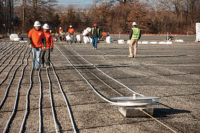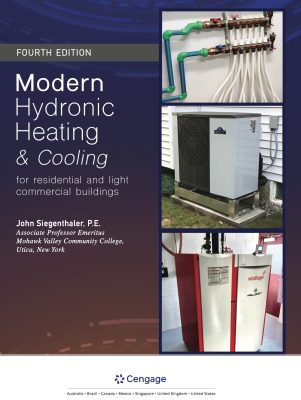Radiant Comfort Report
Jimmy Diresta adds radiant heat
Radiant system creates comfortable work space for well-known artist.

From left to right: Mordy Schwartz, Ari Rosenbloom, Meir Kirshenbaum, Moe Hirsch and Jimmy Diresta.

From left to right: Ari Rosenbloom, lead technician; Moe Hirsch; Jimmy Diresta; Mordy Schwartz, apprentice; and Meir Kirshenbaum, apprentice/scheduling.

Taco’s VT2218 ECM High-Efficiency Circulator comes with two temperature sensors to provide ∆T readings to the pump’s brain.

Moe Hirsch, owner of Moe’s CAMs (Consulting and Mechanical Services) in Pomona, New York, uses only one pump, a Taco VT2218, across the whole hydronic system.

Hirsch explains several of the hydronic system components to Diresta.

Hirsch installs a Taco 4900 air separator.

Hirsch explains how to use the ProPress system to Diresta.







Some talented people seem to have the ability to create anything. Regardless of what they apply themselves to, the end result is always stunning. Upstate New York is home to one of these independent, relentless creative minds.
In Jimmy Diresta, genius, vision, originality and the spirit of craftsmanship come together. Known best for creating functional art of all variety, he’s an inventor, artist, fabricator, TV personality, podcaster, author, video producer, prolific YouTuber and social media star. Whether he’s hand-crafting tools or building a wooden canoe, Diresta’s work is unique and always documented on his YouTube channel.
“I’ve been a lifelong maker,” Diresta says. “It started in elementary school, and I’ve done nothing else since.”
His most widely-known project was fabrication of an AK-47-themed guitar, or “Gattar” for musician Wyclef Jean. According to the rapper, the functioning musical instrument symbolizes music as a weapon. The ubiquitous Kalashnikov was chosen because, since its inception in 1947, it has come to symbolize “revolution.”
Crazy guitars aside, in Diresta’s mind, his greatest creation has been his YouTube channel.
“I capture, edit and market all my own content and have attracted an audience that appreciates the work I do,” Diresta says, referring to his 1.8 million subscribers. “There are 329 million channel views, and it’s become my online portfolio.”
That portfolio has attracted attention from a lot of big names. Diresta has collaborated with a wide variety of companies, including DeWalt, Bulleit Whiskey, Carhartt, Carolina Shoe, Guinness and others.
More creative space needed
As Diresta’s online presence grew, he found himself with a good problem — he needed more space.
“In 2004, I bought a farm in the country with intentions to build a barn, to become my main workshop,” he explains. “I was working in the city at that time, and it wasn’t until I started making money on YouTube that I could fulfill the dream.”
In 2017, Diresta took the plunge, beginning construction on the 40-foot by 72-foot pole barn — called, simply, the Black Barn — that would ultimately become an event space, rather than the workshop he’d initially envisioned. The barn is now where he hosts blacksmithing and woodworking classes on the weekends.
Like many of the things that Diresta is involved with, the construction project became a group effort between a number of other creators and social media influencers. Kyle Stumpenhorst (@RRBuildings) was hired to build the frame and roof, using construction of the building to launch his own YouTube channel. David Parraguirre (@TheMexicanCarpenter101) completed the building, including flooring, paint, exterior, windows and layout of half-inch radiant tubing at 12-inch centers before the shop’s slab was poured.
“I chose these craftsman for the project because they’re meticulous and extraordinarily talented,” Diresta says. “I wanted the job done right, and I wouldn’t have been as meticulous on a construction project myself.”
Every time he brought up construction of a pole building, people recommended installing a radiant heating system to combat the big winters in upstate New York. Diresta had the radiant tubing installed but held off on the boiler.
During construction of the barn, work halted for an extremely rainy day. Diresta salvaged that day by hosting a meet and greet of sorts, for people in the area that wanted to chat with himself, Stumpenhorst or Parraguirre. In attendance was Moe Hirsch, owner of Moe’s CAMs (Consulting and Mechanical Services) in Pomona, New York.
“Moe’s passion for hydronics was evident immediately, and we discussed the installation of a boiler for the radiant system,” Diresta says. “We left it there for almost two years, but in 2019, I contacted Moe, and he came back out to the farm to begin designing a system.”
No T-stats
Hirsch started with a heat load calculation. The building has blanket insulation on the walls and spray foam in the ceiling. Diresta wanted to maintain 60° F indoors on a regular basis with the ability to bring the space up to 70° F during events.
Hirsch found the load to be 105 MBH. His plan was to install a Viessmann condensing boiler and a single Taco VT 2218 circulator in Delta-T mode to serve the 12-loop radiant system.
“I use Taco Delta-T circulators on all my radiant jobs, but having a pump respond to return water temperatures was especially important on this project,” Hirsch says. “I used a 20° Delta here. Nobody is walking around in the shop with bare feet, so if there’s a slight surface temperature inconsistency, it’s irrelevant, and a small price to pay for the efficiency gained by wringing every last drop of condensate out of the heat exchanger.”
The Black Barn doesn’t have a thermostat. Diresta simply controls the temperature of the building via the boiler’s mobile app, which is linked to the unit’s outdoor reset control. Rather than the boiler getting an open/close signal, it receives direct feedback, and sets a supply water temperature based on the outdoor reset control.
The hydronic system is quite simple. Diresta wanted as few moving parts as possible. A single circulator serves the entire system. It pumps directly into and out of the high volume, low pressure drop boiler, and circulates the slab. There are no mixing valves or closely-spaced tees. On a -5° design day, supply water temperatures reach 100°. Never more.
Additionally, a Taco 4900 air separator is installed high on the near boiler piping. Though this installation was new, Hirsch finds the slightly wider fitting to fitting width of the 4900 to be a big advantage in replacement situations.
“The width of this air separator allows me to cut out most failed separators and install the new one without having to add pipe,” he explains.
Hirsch also installed a 20-gallon Axiom glycol feeder with Hercules antifreeze mixed to provide protection down to 0°.
Refuge from the cold
“In one respect, this job was no challenge at all,” Hirsch explains. “Jimmy was extremely accommodating. He had prepped and painted the wall behind the boiler, there was ample space to work in, and there were no steps to navigate, no molding to protect, etc. On the other hand, everything outside was covered in ice for the duration of the project, and the job is very remote with no supply houses within an hour-and-a-half. But Jimmy understood all of this and was patient.”
Like all the appliances on the property, the new boiler is propane-fired. A master switch in the mechanical space allows Diresta to disconnect the hydronic system and use generator power.
“Ice storms aren’t uncommon here and can disrupt power supply,” Hirsch says. “The boiler draws very little power and the single ECM pump uses just a bit more. Jimmy can run this entire heating system on the smallest emergency generator.”
The boiler install was wrapped up in mid-December, with plenty of heating season left for Diresta to appreciate the improvement.
“Everyone said I’d be foolish if I didn’t install a radiant system in the shop,” Diresta says. “I was told that it’s the most economical and comfortable option for of heating a big open space like this. Now that it’s operational, I can’t agree more! It’s always comfortable, even if it’s 10° F outside. And that’s what I was looking for, a refuge from the cold.”
“Just like David and Kyle, Moe is a master of his craft,” continues Diresta. “The three of them delivered exactly what I was hoping for, and more. They’ve created a beautiful, useable, comfortable space that has allowed me to expand and diversify my operation here on the farm. In a lot of ways, this is a culmination of a dream for me, and I’m proud of what we’ve all created here.”
Looking for a reprint of this article?
From high-res PDFs to custom plaques, order your copy today!














